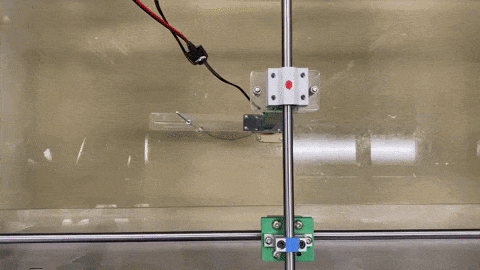Project Title: Tuned constrained beam inspired by anguilliform locomotion
Team 2
| Name | Phone | |
|---|---|---|
| Aniruddha Anand Damle | adamle5@asu.edu | (602) 813-7594 |
| Jacob Yoshitake | jyoshita@asu.edu | (858) 231-4114 |
| Anson Kwan | akwan2@asu.edu | (626) 512-2444 |
| Bryan Carlton | bhcarlto@asu.edu | (480)-677-8602 |
Research Question
Background
We wanted to know how a length-constrained segmented beam with a compliant tail could propagate a sinusoidal wave to produce anguilliform locomotion in this project. Our team members come from various experiences and provide a variety of perspectives to the project. This project aims to replicate the motion of an eel’s tail and enhance the velocity of a similar robot that has already been built. We also want to reduce production costs by employing foldable methods.

Results
- This project has helped to further research into aquatic foldable robots
- It also helped to contribute to the understanding of undulating aquatic animals
- To further progress our research, main things to improve would be to
- Properly scale up the prototype
- Test it in a free swim
- Continue research on the gates of undulating aquatic animals
- The outputs of our parameter optimization are as follows
- Segment Volume - length=27.6mm height=10mm
- Tail Length = 10mm
- Sweep Frequency - 2.13Hz
- Constraint Link Length - 151.8 mm

Conclusions and Future Work
In the future, there are a couple of improvements that we would like to make. The first would be to see if it is possible to convert the stiff spine into a foldable part. The current design uses a 3D printed spine to provide a rigid structure that the two pivot points and the motor mounts to. To replace this, a future team could look into creating a laminate structure that doubles up the current tail thickness to obtain an ideal thickness. Second, making the system free-floating and designing it around the weight of the actuator would change how the system was optimized. The current optimization is focused on just the tail without the weight of the motor or any support structure, and the weight of the actuator is too much for the current design to propel. Optimizing the tail with the weight of the motor would definitely change the dimensions of the design. Finally, the shape of the tail could be optimized. For our system, we kept the tail a rectangular shape to make simulation much easier. However, a more optimized tail might be able to handle producing more thrust that could be used for propulsion.
References
[1] G. V. Lauder and E. D. Tytell, “Hydrodynamics of undulatory propulsion,” Fish Physiology, pp. 425–468, 2005.
[2] J. Long, “Muscles, elastic energy, and the dynamics of body stiffness in swimming eels,” American Zoologist, vol. 38, no. 4, pp. 771–792, 1998.
[3] E. D. Tytell and G. V. Lauder, “The hydrodynamics of Eel Swimming,” Journal of Experimental Biology, vol. 207, no. 11, pp. 1825–1841, 2004.
[4] E. D. Tytell, “The hydrodynamics of EEL swimming II. effect of swimming speed,” Journal of Experimental Biology, vol. 207, no. 19, pp. 3265–3279, 2004.
[5] E. D. Tytell, C.-Y. Hsu, T. L. Williams, A. H. Cohen, and L. J. Fauci, “Interactions between internal forces, body stiffness, and fluid environment in a neuromechanical model of lamprey swimming,” Proceedings of the National Academy of Sciences, vol. 107, no. 46, pp. 19832–19837, 2010.
[6] D. Q. Nguyen and V. A. Ho, “Kinematic Evaluation of a Series of Soft Actuators in Designing and Eel-inspired Robot.” International Symposium, Honolulu, 12-Jan-2020.
[7]K. T. Du Clos and J. O. Dabiri, “Thrust generation during steady swimming and acceleration from rest in anguilliform swimmers.” The Company of Biologists Ltd, 2019.